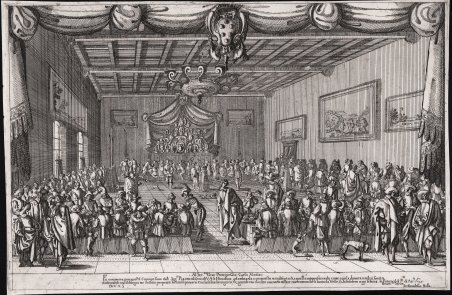Acquaforte , 1627, firmata e datata in lastra.Magnifica prova, molto contrastata, impressa su carta vergata priva di filigrana, con piccoli margini, leggere ossidazioni al verso, per il resto in ottimo stato di conservazione.La prima incisione all’acquaforte di Della Bella, il ' Banchetto dei Piacevoli ' è dedicata al fratello del granduca, Giancarlo de’ Medici.I Piacevoli formavano una società di cacciatori a Firenze, e il banchetto rappresentato avviene in una sala di Palazzo Pitti.Magnifico esemplare di questa famosa incisione, opera giovanile del Della Bella. ' Stefano della Bella fu uno degli incisori più interessanti e originali nella Firenze del XVII secolo e può considerarsi l’unico geniale continuatore dell’opera di Jacques Callot. La sua educazione artistica ebbe inizio a Firenze nella bottega degli orafi Gasparo Mola e Orazio Vanni, e la precisione del segno, tipica dell’arte orafa resterà caratteristica del suo stile. Studiò poi presso Giovanni Battista Vanni e forse anche presso il Cantagallina e Cesare Dandini, ma ben presto si dedicò all'incisione. Il suo vero maestro può considerarsi Jacques Callot, l’incisore francese che soggiornò a lungo a Firenze lasciando una forte impronta nel panorama artistico della città. Gli anni più importanti della sua carriera sono quelli che trascorre a Parigi, dal 1639 al 1650, stipendiato da Lorenzo de' Medici: lavorò insieme ad Israel Silvestre, con gli editori Langlois, Ciartres e Pierre Mariette, per stampatori francesi e per commissioni di gran prestigio, come quelle del 1641 per il cardinale Richelieu che gli affidò le illustrazioni delle sue imprese guerresche. Intorno al 1647, durante un viaggio in Olanda, dove eseguì le acqueforti con le vedute del porto di Amsterdam, incontrò Rembrandt e da quella data notiamo una eco profonda dell’arte dell’olandese nella grafica del Della Bella. ' Etching, 1627, lettered ' at bottom center: 'Al Ser.mo Gran Principe Gio Carlo Medici' followed by two lines in Italian; lettered at bottom right: 'In Firenze il di P. di Ag. 1627 / Devot: Servo / Stefano della Bella' and at bottom left: 'Di. V. A. S.'Magnificent work with strong colour contrast, printed on contemporary laid paper without watermark with thin margins, light oxidations on verso, otherwise in excellent condition.The first etching ever realized by Della Bella, the Banchetto dei Piacevoli, was dedicate to the brother of the grand Duke, Giancarlo de’ Medici, ' Bishop of Sabina (1611–1662) ' The banquet of the Piacevoli hunting society; in a large hall, a large number of men seated at long tables placed along the length The print commemmorates a banquet held possibly in the Medici villa at Pratolino but more probably held in the Pitti Palace, with its round-headed windows.of the walls with a space at centre, pictures hanging on the walls and a large display of dishes at the far end, with the Medici arms above, with many serving men and dogs. ' Stefano della Bella was one of the most interesting and original engravers in 17th-century Florence and can be considered the only brilliant continuator of Jacques Callot's work. His artistic education began in Florence in the workshop of the goldsmiths Gasparo Mola and Orazio Vanni, and the precision of sign, typical of the goldsmith's art, will remain characteristic of his style. He then studied under Giovanni Battista Vanni and perhaps also under Cantagallina and Cesare Dandini, but soon turned to engraving. His real master can be considered Jacques Callot, the French engraver who stayed in Florence for a long time and left a strong imprint on the city's artistic scene. The most important years of his career were the ones he spent in Paris, from 1639 to 1650, salaried by Lorenzo de' Medici: he worked together with Israel Silvestre, with the publishers Langlois, Ciartres and Pierre Mariette, for French printers and for commissions of great prestige, such as those of 1641 for Cardinal Richelieu, who entrusted him with illustrations of his warlike exploits. Around 1647, during a trip to Holland, where he executed etchings with views of the port of Amsterdam, he met Rembrandt, and from that date we note a profound echo of the Dutchman's art in Della Bella's graphic work. Magnificent example of a famous engraving, early work of Della Bella.Collection mark of ' Rev. J. Burleigh James (Lugt 1425). Cfr.

Découvrez comment utiliser
Découvrez comment utiliser

